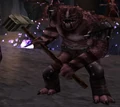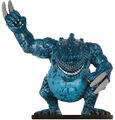m (→Slaad Lords) |
LhynardBot (talk | contribs) m (adding autocats to alignment grid) |
||
| Line 10: | Line 10: | ||
| type5e = [[Aberration]] |
| type5e = [[Aberration]] |
||
| subtype5e = |
| subtype5e = |
||
| − | | alignment5e = {{ |
+ | | alignment5e = {{Alignment grid|cats=yes|off|off|off|off|off|on|off|off|on}} |
| challenge5e = |
| challenge5e = |
||
| refs5e = <ref name="MM5e-p274-278">{{Cite book/Monster Manual 5th edition|274-278}}</ref> |
| refs5e = <ref name="MM5e-p274-278">{{Cite book/Monster Manual 5th edition|274-278}}</ref> |
||
Revision as of 03:59, 21 April 2020
Slaadi (singular: slaad, pronounced: /slæd/ slæd[6] or: /slɑːd/ slad[6]) were bipedal, frog-like creatures native to Limbo[7][1] and to the Supreme Throne.[8]
Description
Their base form was that of a large bipedal frog, though some of the more powerful slaadi had polymorph self or shapechange abilities and sometimes appeared as humanoids.[1] In frog form their heads were huge and their claws were extremely sharp. They spoke their own language and, occasionally, some additional evil languages. Telepathy, however, allowed them to understand and converse with all things. There were many types of slaadi depending on their place of origin and rank within their society.
The most common types of slaadi were blue slaadi, green slaadi, red slaadi, gray slaadi (the executioners), and death slaadi (the lesser masters). Some were even white slaadi like Chourst, and very rarely did they turn into black slaadi. Size also varied between the different subtypes, from human-sized to several feet taller. Most Slaadi were almost always chaotic neutral, with the exception of death slaadi, which were usually chaotic evil, and the gormeel slaadi, which were lawful neutral. All slaadi, being outsiders composed of the essence of Limbo itself, had natural darkvision of up to 60 feet.
Society
Slaadi had been depicted as having a complex social system bound up in the relationship and reproductive cycles of the various types. Some types would naturally dominate others, though as slaadi were creatures of chaos, such domination occured not through a regimented hierarchy, but by brute force. In earlier times[as of when?] a symbol of power was embedded in each slaad's forehead, and non-magical tattoos on the forehead represented achievements and status.[9] These markings did not appear commonly as they once had, and most of the time the hierarchy was based solely on whoever was the stronger. For a long time it was believed that the aforementioned types of slaad had been the only ones in existence, but in recent years[as of when?] the mud slaadi, as well as the superior white and black slaadi were also discovered. It had also been determined that the slaadi race was ruled by two Slaad Lords known as Ssendam and Ygorl.[citation needed]
Reproduction
Red and blue slaadi reproduced by infecting living hosts. The red did so by implanting eggs beneath their victim's skin which grew into a blue slaad tadpole that ate the host from within. The blue infected the host with a lycanthropy-like disease called chaos phage that slowly transformed them into a red slaad.[1] Whether the transformation was mental was unknown. Despite being the means of producing the other slaad type, reds and blues despised one another.[citation needed]
If either a red slaad or blue slaad infected a spellcaster, the host would spawn a green slaad, superior to its parent in that it might cast spells.[1] A green slaad, upon reaching its hundredth year of life, would retreat into isolation for the duration of about a year. Upon its return, it would have transformed into a smaller, but more powerful grey slaad, which focused more on spellcasting than most of the other slaadi.[citation needed]
Some grey slaadi might undergo an unnamed, mysterious ritual, which transformed them into death slaadi. Death slaadi possessed amazing magical and physical might, but eschewed focusing on the former, as the greys did, being bent more on perpetuating slaughter and death. As such, death slaad tended to lean towards an evil alignment than did most other slaadi.[citation needed]
If the death slaad survived a century, it turned into the white slaad.[10] And if the white slaad survived a century, it turned into a black slaad in the manner of its preceding transformations. The black slaad was the most powerful slaad, excluding the slaad lords themselves.[11][12]
The Spawning Stone was the primordial home of the slaadi, located in "a realm of their greatest dominion" which drifted about Limbo. The passage of the stone generated currents in the raw chaos-stuff of the plane, and slaadi were able to follow these currents "upstream" to the Stone's location. In the mating season, each race of slaad converged on the Spawning Stone, wresting the Stone away from the previous group, so that they might fertilize each others' internal egg sacs, and carry away the seed-like fertilized eggs for later implantation into host bodies. Sometimes, however, young slaadi were produced right there at the stone because the slaadi implanted each other in their mating frenzy. Thus, dead adult slaadi routinely floated about the stone until destroyed by the chaos of Limbo.[citation needed]
True slaadi were described as beings of ultimate chaos who had no set form. Only the Slaad Lords Ssendam and Ygorl were representative of this type. Somehow they affected the Spawning Stone to prevent the emergence of slaadi more powerful than themselves, which kept the slaadi within the aforementioned groups. Although anomalies did slip through in the chaos, they had less variety and a lower chance of being more powerful than the Slaad Lords.[13] One such anomaly was the gormeel[14], which was a large, mutant variety "born from the Spawning Stone", provided that they were lucky enough to escape the notice of Ygorl and Ssendam. They were lawful in alignment, serving as allies and sometimes mounts of the githzerai against other slaadi.
History
According to some scholars, the slaadi were descendant from the batrachi, one of the creator races,[15] though a being that claimed itself to be a batrachi denied this claim.[16]
Other sages claimed that the slaadi originated as an unintended side effect of the creation of the Spawning Stone by Primus, overlord of the modrons. Primus's intention had been to use the Stone to generate order in Limbo, in order to prevent the chaos from that plane from spreading. The presence of the Stone allowed colonies of githzerai and modrons to be established on the plane, but as it absorbed the surrounding chaotic energy, it also spawned the first slaadi, who immediately set out to exterminate every modron colony on the plane.[1]
Slaad Lords
Slaad Lords were the de-facto rulers of the slaad race. Though true to their chaotic nature they often did not appear anything like other Slaadi.
Appendix
Gallery
Appearances
- Adventures
- Dungeon #43: "Into The Silver Realm" • Dungeon #101: "Prison of the Firebringer" • Curse of Strahd • Tomb of Annihilation • Waterdeep: Dungeon of the Mad Mage
- Comics
Referenced only
- Forgotten Realms: "Converging Lines"
- Board Games
- Betrayal at Baldur's Gate
- Video Games
- Neverwinter Nights • Forgotten Realms: Demon Stone
- Adventurers League
- Dark Pyramid of Sorcerer's Isle • Escape from Phlan
External Links
 Slaad article at the Eberron Wiki, a wiki for the Eberron campaign setting.
Slaad article at the Eberron Wiki, a wiki for the Eberron campaign setting.
References
- ↑ 1.0 1.1 1.2 1.3 1.4 1.5 1.6 1.7 Mike Mearls, Jeremy Crawford, Christopher Perkins (2014-09-30). Monster Manual 5th edition. Edited by Scott Fitzgerald Gray. (Wizards of the Coast), pp. 274–278. ISBN 978-0786965614.
- ↑ Mike Mearls, Stephen Schubert, James Wyatt (June 2008). Monster Manual 4th edition. (Wizards of the Coast), p. 238. ISBN 978-0-7869-4852-9.
- ↑ Skip Williams, Jonathan Tweet, Monte Cook (July 2003). Monster Manual v.3.5. (Wizards of the Coast), pp. 228–231. ISBN 0-7869-2893-X.
- ↑ Claire Hoffman (2015-03-01). Dark Pyramid of Sorcerer's Isle (DDEX1-11) (PDF). D&D Adventurers League: Tyranny of Dragons (Wizards of the Coast), p. 5.
- ↑ 5.0 5.1 Andy Collins, Bruce R. Cordell (July 2002). Epic Level Handbook. (Wizards of the Coast). ISBN 0-7869-2658-9.
- ↑ 6.0 6.1 Frank Mentzer (January 1985). “Ay pronunseeAYshun gyd”. In Kim Mohan ed. Dragon #93 (TSR, Inc.), p. 28.
- ↑ Brian R. James, Ed Greenwood (September 2007). The Grand History of the Realms. Edited by Kim Mohan, Penny Williams. (Wizards of the Coast), p. 5. ISBN 978-0-7869-4731-7.
- ↑ Richard Baker, James Wyatt (March 2004). Player's Guide to Faerûn. (Wizards of the Coast), p. 163. ISBN 0-7869-3134-5.
- ↑ Allen Varney, ed. (June 1994). Planescape Monstrous Compendium Appendix. (TSR, Inc.), pp. 88–91. ISBN 978-1560768623.
- ↑ Andy Collins, Bruce R. Cordell (July 2002). Epic Level Handbook. (Wizards of the Coast), p. 218. ISBN 0-7869-2658-9.
- ↑ Andy Collins, Bruce R. Cordell (July 2002). Epic Level Handbook. (Wizards of the Coast), p. 219. ISBN 0-7869-2658-9.
- ↑ Eric Cagle, Jesse Decker, James Jacobs, Erik Mona, Matthew Sernett, Chris Thomasson, and James Wyatt (April 2003). Fiend Folio. (Wizards of the Coast), p. 157. ISBN 0-7869-2780-1.
- ↑ Jeff Grubb, Bruce R. Cordell, David Noonan (September 2001). Manual of the Planes 3rd edition. (Wizards of the Coast), p. 96. ISBN 0-7869-1850-8.
- ↑ Chris Thomasson (April 2003). “Killing Cousins: Githzerai Hit Squads”. In Jesse Decker ed. Dragon #306 (Paizo Publishing), pp. 57–58.
- ↑ Ed Greenwood, Eric L. Boyd, Darrin Drader (July 2004). Serpent Kingdoms. (Wizards of the Coast), p. 55. ISBN 0-7869-3277-5.
- ↑ Brian R. James, Ed Greenwood (September 2007). The Grand History of the Realms. Edited by Kim Mohan, Penny Williams. (Wizards of the Coast), p. 5. ISBN 978-0-7869-4731-7.












